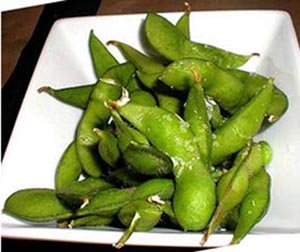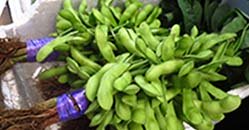Edamame (枝豆) Nutrition facts
Edamame, also popular as green vegetable soybeans or mangetout, are raw, young, immature beans in the pod of a soybean plant. The beans are particularly popular in East-Asian cuisine, especially in Japan, Korea, and China. These garden pea look-alike pods are silently gaining popularity inside the USA and in some European countries as well where sizeable East-Asian populations are present.
Binomially, Edamame, similar to soybean, is an annual dicotyledonous plant, belonging to the family of Fabaceae (Leguminosae), in the genus, Glycine.
Scientific name: Glycine max. (L.) Merr.
 |
| Boiled and salted edamame bean pods. Courtesy: Rick |
soybeans is a very rapid-growing, small annual plant reaching about 2-3 feet in height. It flourishes in well-drained sandy soil along with adequate moisture. Short-stalked green pods cover the entire soy plant about 70 days after plantation. Young edamame pods feature about 1.5-2 inches long, swollen, straight, or slightly curved, filled with a single row of 2-5 light green, smooth seeds. If left, the seeds continue to mature further and dry in the pods.
Harvesting is done by handpicking individual pods. In Japan, the whole soy plant is cut at the soil surface or pulled off the ground, bundled in small bunches, and dispatched for markets.
Boiled beans possess a soft, creamy texture and delicately beany taste akin to that of lima or hyacinth beans.
Health Benefits of Edamame beans
Like wasabi, edamame beans too are uniqe to Japanese culinary tradition. Green soybeans play a vital role as important sources of plant protein.
100 g beans carry 110 calories and provide 10.25 g or 18% of the daily recommended intake of protein.
Edamame contains moderate amounts of vitamins, minerals, fibers, and plant sterols.
Fresh edamame is an excellent source of folates. 100 grams of fresh beans carry 303 µg or 76% of folates. Folate, along with vitamin B-12, is one of the essential components of DNA synthesis and cell division. Consumption of a diet adequate in folates around conception and during pregnancy time would help prevent neural tube defects in the newborn baby.
Green soybeans are good sources of many B-complex vitamins, especially riboflavin, pyridoxine, thiamin (vitamin B-1), pantothenic acid, and niacin. Most of these vitamins work as co-enzymes in carbohydrate, protein, and fat metabolism.
Fresh beans contain moderate levels of vitamin C (provides 9.7 mg or about 16% of DRI). Vitamin C is a natural antioxidant. Studies suggest that it helps prevent free radical injury, and acts as an immune booster, and anti-inflammatory agent.
Furthermore, beans indeed are one of the ideal sources of minerals like calcium, iron, copper, manganese, zinc, and magnesium. 100 g of fresh beans hold 26% DRI (daily recommended intake) of iron, 56% of magnesium, 36% of copper, and 73% of manganese. Manganese is used by the body as a co-factor for the potent antioxidant enzyme, superoxide dismutase.
| Principle | Nutrient Value | Percent of RDA |
|---|---|---|
| Energy | 109 Kcal | 5.5% |
| Carbohydrates | 7.61 g | 6% |
| Protein | 11.22 g | 20% |
| Total Fat | 4.73 g | 23.5% |
| Cholesterol | 0 mg | 0% |
| Dietary Fiber | 4.8 g | 13% |
| Vitamins | ||
| Folates | 303 µg | 76% |
| Niacin | 0.925 mg | 6% |
| Pantothenic acid | 0.535 mg | 11% |
| Pyridoxine | 0.135 mg | 10% |
| Riboflavin | 0.265 mg | 20% |
| Thiamin | 0.150 mg | 12.5% |
| Vitamin A | 0 IU | 0% |
| Vitamin C | 9.7 mg | 16% |
| Vitamin E | 0.72 mg | 5% |
| Vitamin K | 31.4 µg | 26% |
| Electrolytes | ||
| Sodium | 6 mg | <1% |
| Potassium | 482 mg | 10% |
| Minerals | ||
| Calcium | 60 mg | 6% |
| Copper | 0.324 µg | 36% |
| Iron | 2.11 mg | 26% |
| Magnesium | 224 mg | 56% |
| Manganese | 1.672 mg | 73% |
| Phosphorus | 161 mg | 23% |
| Zinc | 1.32 µg | 12% |
Selection and storage
Fresh edamame beans on the plant (put for sale) can be found in the Japanese and other East-Asian markets. Inside the US, however, frozen pods in vacuum packs or frozen shelled edamame beans (mukimame) can be available in supermarkets. In Japan, entire soy plants with fresh pods are cut at the soil surface and sold in bundles.
Green soybeans have a narrow harvesting period. Young, tender pods are brimming with seeds, just short of their peak maturity considered as the best quality. If left unharnessed at this stage, they continue to grow into dry soy seeds.
While buying fresh edamame bean pods from the local vegetable markets, look for green, just mature, plump, and firm pods. You may also purchase fresh or frozen beans (mukimame) from the grocery.
Avoid sunken, yellow, shriveled pods as the beans convert their sugars into starch. As in other beans, fresh tender beans feature a smooth, pale green color, but their color changes to white or cream-yellow once they dried.
Once picked up, green soybeans should be used quickly since their sugar converts to starch and seeds lose their biting, creamy texture, and nutty flavor.
Once at home, if not used right away, keep them inside the refrigerator where the pods stay fresh for 2-3 days.
Preparation and serving methods
In Japan, fresh edamame beans in pods are boiled in salted water and served in a bowl as a snack. To eat, remove the string, hold the pod in both hands, and then using thumb and index fingers, gently squeeze beans, guiding them into the mouth. Then, discard the pod peel. As in lima beans, edamame also becomes flavorful once cooked.
Here are some serving tips:
 |
| Edamame bean pods on a soy plant. Photo courtesy: acme. |
Boiled edamame beans can be a great addition to green salads. Fresh, beans are treated like other green beans like peas, lima, etc, as bean vegetables.
In Japan, Izakaya restaurants serve boiled edamame pods as an appetizer with drinks.
Add shelled edamame beans (mukimame) in stir-fries.
Zunda mochi is a mashed, sweetened shelled edamame (mukimame) paste served over rice cakes is another Japanese recipe.
Safety profile
Edamame should always be cooked before eating. As in other green beans like lima and hyacinth, raw edamame also carries many anti-nutritional substances, phytoestrogens, and toxins which may affect health adversely.
Consumption of raw edamame beans may cause stomach upset, diarrhea, and vomiting. Boiling in saltwater for at least 20 minutes eliminates most of these toxins and makes the beans flavorful. Additionally, avoid them if allergic to any soy products. (Medical disclaimer)
Related reading:-
Soybeans nutrition facts and health benefits.
Sugar snap peas nutrition facts and health benefits.
Fava beans nutrition facts and health benefits.
Lima beans nutrition facts and health benefits.
Legumes nutrition page.
≻≻-Back to Vegetables from Edamame nutrition. Visit here for an impressive list of vegetables with complete illustrations of their nutrition facts and health benefits.
≻≻-Back to Home page.
Further Resources:
Stanford School of Medicine Cancer information Page- Nutrition to Reduce Cancer Risk.
Specialty Soybean Production and Management in Kentucky-pdf.